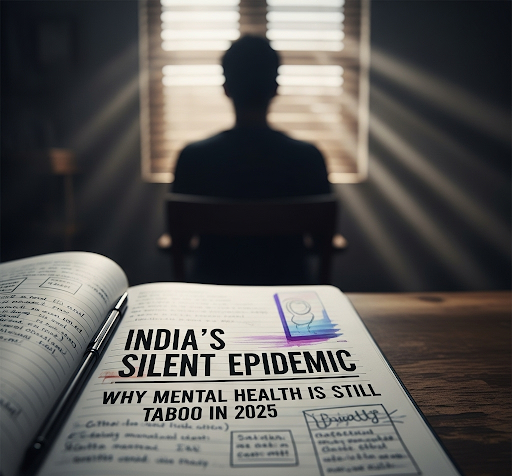India’s Silent Epidemic: Why Mental Health Is Still Taboo in 2025

Introduction
In 2025, India finds itself at a crossroads. While technological advancements and social change are reshaping the country, one crisis remains largely in the shadows: mental health. For millions of Indians, particularly young adults and working professionals, the daily battle with anxiety, depression, and burnout continues to unfold in silence.
Despite increased global awareness and a boom in mental wellness startups, stigma still clings tightly to the idea of seeking help. In many Indian households, talking about mental health is still equated with weakness or insanity. But the silence is becoming dangerous.
The Numbers That Can’t Be Ignored
According to the National Mental Health Survey, nearly 1 in 7 Indians suffer from mental disorders. More alarming is that 70% of youth reporting mental distress never receive any professional help. Suicide continues to be one of the leading causes of death among Indians aged 15–29.
Burnout is no longer just a buzzword. The corporate grind in metropolitan hubs like Bengaluru, Mumbai, and Gurgaon has led to increased absenteeism, quiet quitting, and stress-related illnesses. But why does the silence persist?
The Cultural Roadblocks
Mental illness in India is often viewed through a cultural lens of shame and secrecy. Families may hide diagnoses. Schools still lack trained counselors. Religious and spiritual remedies are often preferred over therapy.
Many young Indians are raised to prioritize resilience over vulnerability, making it difficult to admit they’re struggling.
"I couldn't even tell my parents I was in therapy," says Aanya, a 23-year-old student from Delhi. "They'd think something was wrong with me."
This emotional suppression is especially pronounced in Tier 2 and Tier 3 cities, where awareness is lower and access to resources is limited.
Are Therapy Apps Helping?
Startups like Mindhouse, Wysa, YourDOST, and Lissun have emerged with mobile-first solutions for therapy. These platforms are often affordable, anonymous, and AI-powered, making them more appealing to India’s tech-savvy youth.
Yet, challenges remain. Many users stop therapy after just one session. Language barriers, poor internet access in rural areas, and lack of clinical regulation raise important concerns about the efficacy and equity of these platforms.
Influencers: The New Mental Health Advocates
Social media influencers and creators are stepping in where traditional institutions have failed. Instagram accounts and YouTube channels are normalizing therapy and ADHD diagnoses, while TikTok therapists share mini-lessons on boundaries, burnout, and trauma.
Campaigns like #ItsOkayToTalk, #MentalHealthMattersIndia, and #TherapyIsCool are helping remove stigma. Influencers like Ankur Warikoo, Prajakta Koli, and Dr. Sid Warrier have used their platforms to discuss therapy, burnout, and emotional wellbeing.
However, this democratization also brings risks: misinformation, toxic positivity, and unqualified advice often go viral, blurring the lines between awareness and accuracy.
Workplace Burnout: A Quiet Corporate Crisis
India’s startup ecosystem has glamorized the hustle culture, often at the cost of mental wellbeing. Employees, especially in tech, finance, and content sectors, are experiencing chronic fatigue, anxiety, and emotional exhaustion.
Companies like Zomato, Swiggy, and TCS have introduced wellness days, employee therapy packages, and burnout audits. But adoption is inconsistent. HR teams remain under-equipped, and mental health policies often look good only on paper.
Read our blog on Side Hustles 2025 to explore how creators are monetizing self-care.
Public Campaigns and Government Involvement
Post-pandemic, the Indian government did take small steps. The Tele-MANAS helpline was introduced to provide tele-counseling. Mental health has now been included in the National Health Mission. Yet, India still spends only 0.05% of its health budget on mental health.
NGOs like The Live Love Laugh Foundation, Manas Foundation, and Sangath continue to fill gaps with school programs, community therapy, and training modules. But scaling impact in a country of 1.4 billion remains a massive challenge.
What Still Needs to Change
- Schools must integrate emotional literacy and safe spaces for young people.
- Workplaces need mandatory mental health policies and leadership training.
- Therapy must be destigmatized across languages, classes, and geographies.
- Men must be encouraged to speak out, as gender stereotypes still discourage emotional expression.
- Community-level awareness, especially in rural India, is critical.
Conclusion: Ending the Silence
India’s mental health epidemic won’t be solved overnight. But with sustained awareness, cultural dialogue, and systemic action, we can make room for empathy over shame.
Mental health is not a luxury. It’s healthcare.
What will it take to end the silence around mental health in India?
Tag an organization or individual who’s making a difference. Share this blog. Start a conversation. Change begins with honesty—and it begins with us.



